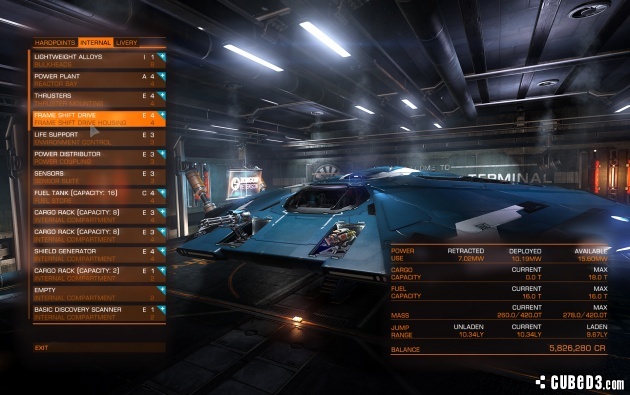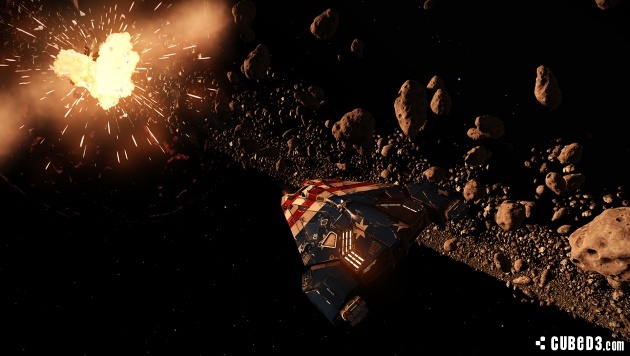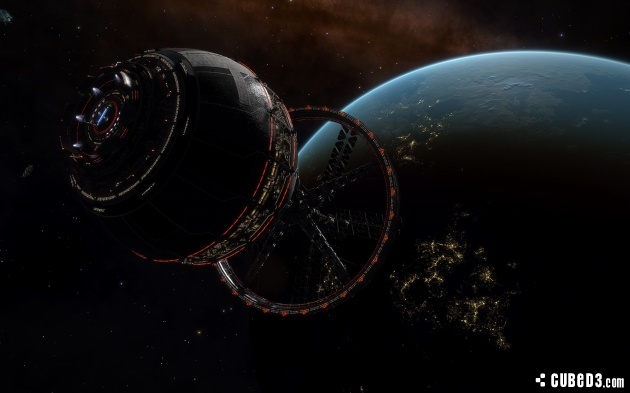Elite: Dangerous (PC) Review
By Jordan Hurst  09.03.2015
09.03.2015

The team behind Elite: Dangerous deserves the utmost respect. Its game is a technical masterpiece - a confluence of extensive procedural generation, scientific accuracy, and insanely detailed mechanical systems, creating a singularly absorbing and realistic space sim. Just because it deserves gamers' respect, however, does not mean it deserves their money. Actually purchasing Elite: Dangerous is not recommended; its content is stretched as thin as possible, it's as unwelcoming to new players as any game of its genre, and for all its grandiosity and complexity, it's extremely repetitive. With it, Frontier Developments has basically declared itself the game development equivalent of session musicians - remarkably talented people who have no business creating their own material.
Ultra-realistic simulation is one of the hardest game categories to explain the appeal of. Space trading simulators make a little more sense, though - they recreate an activity that will almost definitely not exist in the lifetime of anyone playing, but do so in such a way that they remain grounded and seemingly attainable. Realistic fantasy is all well and good, but the innumerable steps taken in Elite: Dangerous to keep the realism consistent are a reminder of why gameplay is so abstracted in more traditional games. "Time-consuming" is the best word to describe the game. Every single action that would have been glossed over anywhere else is instead fully depicted and required, no matter how mundane it is. Ports give players a ten minute timer to dock after requesting permission, and that's only a slightly liberal estimate of how long the procedure actually takes.
That comment about the game's content being stretched as thin as possible is completely literal - the game takes place in a 1:1 scale recreation of the Milky Way, brought to life via a combination of real-life astronomical data and extrapolative algorithms. This is the premier example of Elite: Dangerous including features for their own sake. It is humanly impossible to create something simultaneously large and interesting enough to justify recreating the entire galaxy in order to house it. Elite: Dangerous has the "large" aspect figured out, and that's about it. At 400 billion star systems, the game is the most complete empty space simulator the market has ever seen. Criticising a space flight simulator for being too empty feels like criticising a fantasy game for including swords, but it highlights the question the development team should have been asking itself: if a real-life activity is boring, why create a faithful simulation of it in an entertainment medium?

Make no mistake, Elite Dangerous is as faithful to the (theoretical) real thing as possible. If all genre fans want is to feel like they are really piloting a starship, it's probably their best option. Of course, the learning curve for this is as abrupt as would be expected. The list of all possible key bindings is about ten pages long and probably contains more actions than are actually available on a standard keyboard. Watching the flight tutorial videos is an absolute must for new players, and even once they are finished, it still takes a few hours to figure out how the rest of the game works. Once it's all penetrated, the game is spectacularly immersive. There's something oddly compelling about navigating 3D sensor readouts, diverting power supplies, and collecting free-floating cargo using computer-assisted targeting, mostly because it all feels so real.
The game's atmosphere of playable space epic is perhaps its most powerful asset. Every action is accompanied by a wonderfully fitting orchestral score - new star systems are announced with triumphant but pensive fanfare, space station interiors exude an air of safety and progress, and approaching a destination is surprisingly tense, due almost entirely to the soundtrack. It's also a quietly beautiful game. With so few objects on screen at any given time, Frontier Developments was visibly allowed to pour as many resources as possible into their quality, creating some of the most awe-inspiring celestial bodies ever rendered in a videogame. The game also claims to not have any loading screens, and while that's not really true (hyperspace jumps between systems are pretty obviously hiding load times), they don't break the immersion as in most games. Even the interface, despite its complexity, adds to the atmosphere with its economical presentation.

Unfortunately, the celestial bodies that make the game look so great are nothing more than landmarks in gameplay. Landing on planets and exploring them on foot is planned for an expansion but, for now, planets exist merely for other, more important things to orbit around. It's too bad, because on-foot exploration would have added some much-needed variety to the gameplay. The game's complexity and unnecessarily drawn-out gameplay attempt to hide its repetitiveness, but once the initial confusion is cleared, the game reveals itself as essentially an MMORPG with only minimal multiplayer elements. The manpower used to create the unfathomably large galaxy map showing all manner of trade routes and resource data feels especially wasted at this point. After all, anyone who's bought low and sold high at one space market has bought low and sold high at them all.
Combat is the only part of the gameplay that's actually enjoyable for its own merits, rather than because it leads to numbers becoming steadily larger and to-do list points being checked off. It's just as long, complex, and realistic as the rest of the game, but in the context of space dog-fighting, those all work in the game's favour. Each skirmish feels significant, unlike typical MMO combat, where players must grind through dozens of pathetic enemies just to leave the first area. Not that Elite: Dangerous doesn't also drag at the outset; the starting ship is so ill-equipped and inefficient that the point where players start to feel their power growing doesn't arrive for days, if not weeks of playing. On the plus side, the outcome of combat is entirely based on player skill and equipment, further distancing it from the taint of RNG-heavy MMO gameplay.

The previous games in the Elite series were all essentially single-player MMOs, so turning Dangerous into a full-fledged multiplayer title seems like the logical evolution of the franchise. How a game the size of the Milky Way would support multiplayer was one of the big questions hanging over the game's development. Frontier's answer was pretty much baffling to anyone without a programming background (and even many with), but suffice it to say that the system works well, grouping players together at major locations while spreading them out far enough that individual users still feel like unique entities. It does require a constant Internet connection, but at least that makes sense in this case, unlike…pretty much every previous attempt at always-online dependence.
A constant online connection is required from every player in order to maintain the game's persistent universe, including its economy and faction conflicts, a large percentage of which is player-driven. It's an agreeable middle ground between the rigid, computer-controlled structure of previous games, and the lawless, abusive wasteland of EVE Online. In fact, if making a more accessible, less hostile version of EVE one of the development goals, then mission accomplished. Not that that's a particularly difficult accomplishment; a game could be sealed in a bank vault made of mithril and it would still be easier to get into than EVE. This kind of persistence and player involvement also allows for some interesting dynamic storytelling, with factions fluctuating in strength as players complete missions. It is, by necessity, rather diluted, but it helps to distract from the aimless gameplay nonetheless.

Cubed3 Rating
Average
Come to think of it, "aimless" would also make for an excellent one-word description of Elite: Dangerous. Frontier Developments has crafted a first-rate simulation and supported it with meticulously-detailed systems, but then failed to do anything with it, except drop it into the widest, emptiest sandbox imaginable. Perhaps that's all that hardcore space sim fans want, but hardcore fans have likely already bought the game and exhausted most of its content. Anyone else is better off hoping the developer finds work somewhere else, where its incredible talent can be put towards a game that is actually worth playing.

![]() 5/10
5/10
![]() 0
(0 Votes)
0
(0 Votes)
 Out now
Out now  Out now
Out now  None
None  Out now
Out now Comments
Comments are currently disabled

 Sign In
Sign In Game Details
Game Details Subscribe to this topic
Subscribe to this topic Features
Features





 Top
Top

